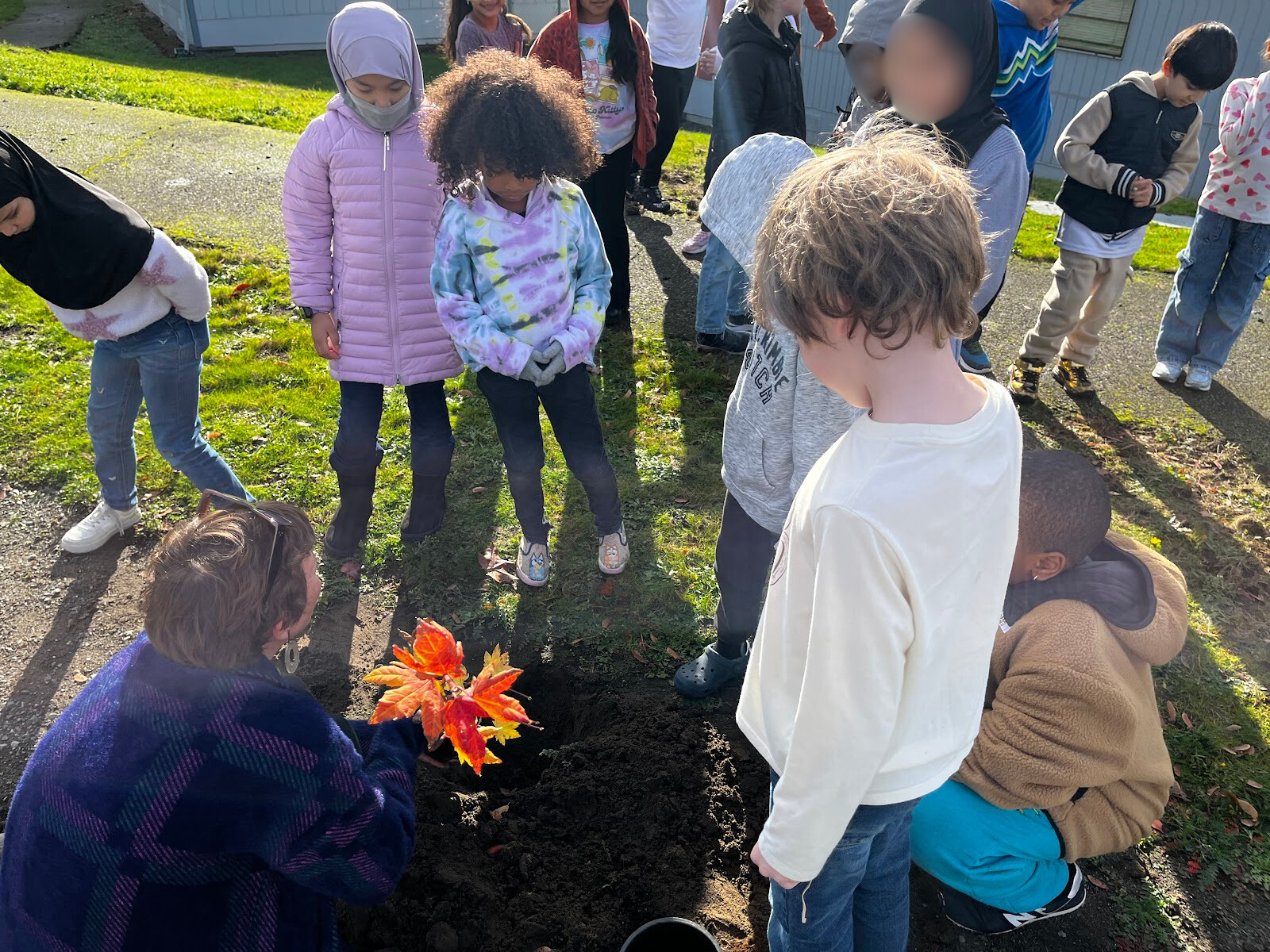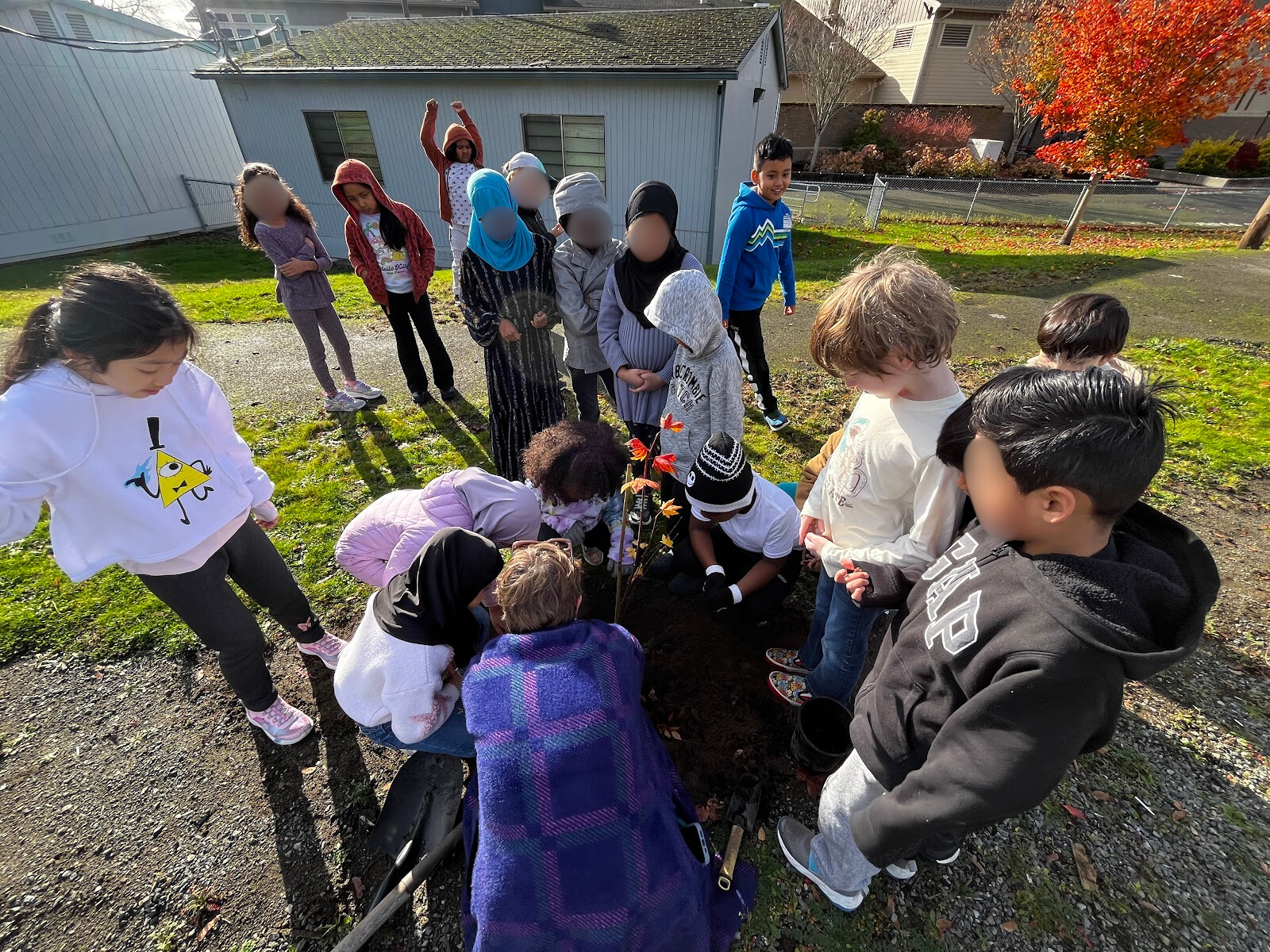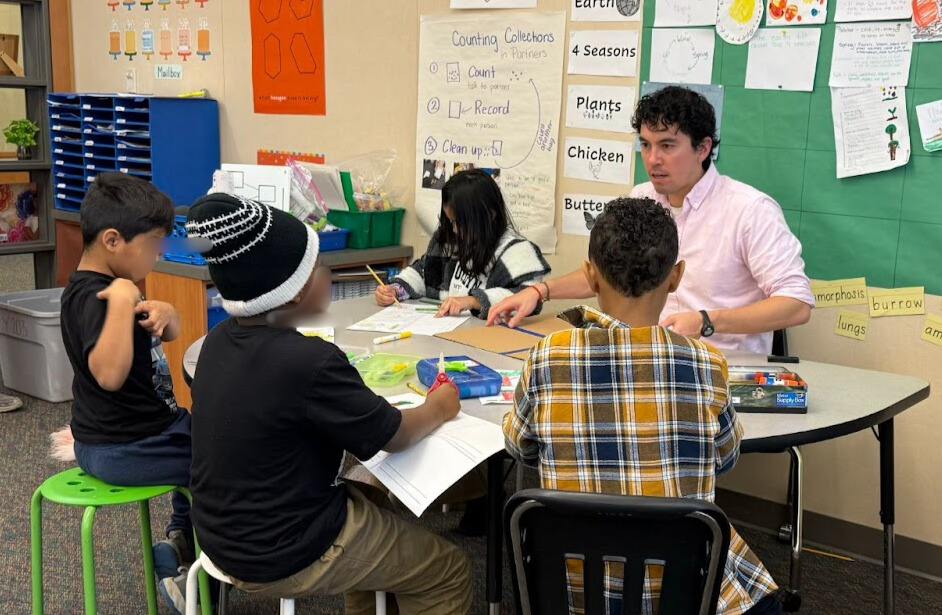
The steps laid out below are illustrated as an example from Teacher Janaki’s work. Our hope is to show a guide to how other teachers can shift from transactional to reciprocal ways of teaching science. Underpinning all of these steps is a genuine desire to build a classroom around care and interdependence – both for each other (within the classroom) and with the natural world outside of it.
Step 1. Audit curriculum with a critical lens
The first official science unit of our school year was around plants and pollination. As I perused the district-given curriculum, I found a series of lessons guiding students through learning the names of plant parts and how pollination works. These lessons were fine, and for the most part, interesting and informative for children learning about new ideas to connect with what they may already know about plants in the world.
However, as a teacher, my view of science includes teaching in a way that not only shares information but pushes children to think critically about the world around them, using their own background knowledge, beliefs, and experiences to do so. The goal of this shift is to help students use science as a tool for building reciprocal relationships with each other, as well as with other humans, animals, plants, and non-living beings in their communities.
In order to do this, I did not necessarily need to throw out any of the lessons or standards that were given to me – but rather, consider the context in which students are learning these ideas, and to what end. This often leads to a shift in how science is taught, not necessarily what is taught (although sometimes, it’s both). I explain what that looked like in the context of this unit on plants and pollination, which can be seen in my Story.
Shifting towards reciprocity:
The first question I found myself asking as I looked at the unit was, “Why do we care about this?” For some children (like myself with space or natural disasters), the answer might simply be, because this is a topic that catches their interest. But in other times, why students care might be related to issues they and their families are well-versed in, and might be tied to problems and solutions that are highly relevant for students. Identifying what these issues are and how they fit into learning objects is an important first step.
It is important to remember how this step helps to move toward reciprocal relationships with students.
In your context:
When auditing and evaluating your curriculum materials through a critical lens, you can ask yourself the following questions.
- What does this step mean?
- How do you use this to push toward reciprocity?
- What are your views of science that need to be critiqued, reckoned with, or uplifted?
- How are you attending to care in both of nature/culture interdependence, but also care within the classroom?
- How can you look beyond the expression of language in order to attend to expanding languages used within the classroom?
Step 2. Adapt curriculum for student interests
As the district-provided sequence of lessons came to a close, it still didn’t feel like the students were ready to be finished learning about plants. Our literacy curriculum included read-alouds about trees and plants, and students were begging for more, connecting the ideas they were hearing in literacy with the work we had done in science thus far.
The important thing to remember here as a teacher is that you are not the knowledge-bearer. We often find success in delivering instruction on topics we enjoy and know well, yet it can be very intimidating to attempt to teach about an idea you don’t feel like an expert in. It’s easy to get stuck on thoughts such as, “what if I don’t know the answer?” or “what if I teach something wrong?”
Shifting towards reciprocity:
At the heart of reciprocal teaching is the disruption of the norms that place the teacher as an expert, filling students’ minds with knowledge. Teachers and students are both able to take on the roles of learners and co-explorers. For this to happen, the teacher must be willing to explore ideas and topics in which they may not be able to provide all the answers.
In your context:
As you consider curricular resources, standards, and central questions to guide your science units, you may also want to consider the opportunities students have to share their interests, explore their own questions, and discuss meaningful issues. One shift that can help to place students with more agency is to consider questions in which the answer is more open ended. While students explore the science topic of trees, and the required resources such as sunlight, water, and nutrients, you may also center questions such as:
- How should we take care of the plants in our environment?
- What is our responsibility for the living things around us?
- How do plants live in relationship to other living creatures and humans?
Step 3: Broadening the scope of reciprocity
Part of the shift towards teaching science through a reciprocal lens includes considering explicitly where knowledge comes from, and why we learn about what we learn about. In the past step, we considered part of this by tailoring ideas to students’ interests. This step is included specifically to make space for broadening the considerations teachers make to identify the ways knowledge is a shared resource between students, teachers, families, communities, and society at large.
Shifting towards reciprocity:
Consider ways that you might draw in knowledge from various sources, as well as opportunities for students to contribute back stories and knowledge to various groups:
- Connect to family stories. This relational move may help to invite students’ families into the classroom space.
- Community or local phenomenon. What issues and events are happening in the communities in which your students live? Are there ways to position even young students as contributors to the community goals?
- Reflect on the goals of standards and assessments. Whose knowledge is being prioritized by these systems? Whose knowledge could be added to the normal school discourse?
Step 4: Research/Sense-making
Students were eager to learn more about trees. Their interest was not limited to our 30 minutes of science time, nor to our literacy unit’s read-alouds. Kids found seeds at recess and brought them inside. They decorated the classroom with drawings of plant life cycles and chose books to read about trees we hadn’t explicitly talked about.
Shifting towards reciprocity:
While teachers might feel pressure to run an efficient classroom, achieve each of the learning goals, and follow the scope and sequence to fidelity, a reciprocal classroom is not always so tidy. Space must be made to allow students to follow their interests, make suggestions for readings and learning work that was unplanned for. Autonomy and agency are explicitly tied to students’ sense-making.
- Consider opportunities for students to build knowledge.
- Identify multiple entry points that allow students to use a diverse repertoire of learning approaches.
- Consider the language needs of students and provide experiential learning that broadens language beyond expressive and receptive modes.
Step 5: Storytelling
When the time came for the unit to close, I wanted to have a culminating project that would showcase both the content students had learned, but also experience the idea of interconnectedness. To achieve this goal, I designed an activity to support students in telling their own stories about trees, care, and interdependent relations.
Shifting towards reciprocity:
Storytelling can be a powerful way for students to communicate their knowledge, experiences, and learning. Such opportunities can make space for students to explain the science ideas that are relevant to the learning, in this example, the biological process of growing trees. The stories can also feature the important characters in the students’ learning and how they relate, emphasizing the interconnectedness of students’ experiences, the trees’ experiences, and those of the community. Stories can also provide space for students to imagine a possible future in which their actions have an impact on the world around them.
In this unit, I provided time for students to individually develop initial ideas for stories about trees of their choice. I then grouped students who were working on similar trees or similar themes and asked them to collaboratively construct a story that included multiple student perspectives and how they each supported the growth and development of the trees.
Step 6: Reflection
Student reflection.
As a final step in this unit, I asked students to reflect on their learning and participation in this unit. This step, while helpful for me as a teacher to further assess student understanding, was primarily completed in order to help students build a sense of how their action guided the development of the lesson. My hope is that these students see themselves as active participants in their own education, as well as active participants in future learning opportunities that can serve communities.
Teacher reflection
Equally important is the reflective process for educators. Individually or as a team of educators, you should reflect on the growth that both educators and students experienced as a part of the reciprocal learning and storytelling. Reflection can help solidify practices that were impactful, identify areas that need more attention in future units, and help better understand how the work of a class is in the community and in conversation with the work beyond the classroom.








 This site is primarily funded by the National Science Foundation (NSF) through Award #1907471 and #1315995
This site is primarily funded by the National Science Foundation (NSF) through Award #1907471 and #1315995